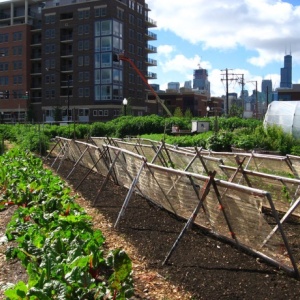
This study looks into how residential landscapes in Chicago, USA, which constitute the largest single urban land use, benefit ecosystems. It argues that even though we often don’t associate modern urban areas with healthy ecosystems, home gardens in urban landscapes can contribute to important ecosystem services.
The study also brings a cultural dimension into the study of urban ecosystem services by looking at how gardening practices varied by area and among different ethnic communities. The different households interviewed were of African American, Chinese-origin and Mexican-origin and the researchers analysed types and relative abundance of the edible plants, ornamental plants, and trees in each garden.
They noted some environmental problems associated with sometimes heavy use of synthetic fertiliser in the home gardens, which could lead to runoff and contamination of surrounding environments, but overall they conclude that urban gardens play an important role in the cultural lives of gardeners and may lead to greater food security where fresh produce is not easily available.
Abstract
With increasing urbanization and environmental degradation, urban landscapes are increasingly expected to provide a wide range of ecosystem services typically associated with rural areas, including biodiversity conservation and food production. Because residential landscapes constitute the largest single urban land use, domestic gardens have emerged as a topic of research interest and planning concern. The ecosystem services (or disservices) these landscapes provide, however, have not been rigorously measured, nor have tradeoffs between the services they provide been assessed. In this study, semi-structured interviews were conducted with 59 African American, Chinese-origin or Mexican-origin households with on-lot or vacant lot food gardens in Chicago. Crop plants and cultivated ornamental plants on the lot were inventoried and mapped at the species level. A total of 123 edible plant taxa from 25 families and 288 ornamental plant species from 85 families were identified, for a combined total of 387 species from 90 families. Cumulatively, the gardens of African American households were relatively rich in ornamental plant species and families, while those of Chinese-origin households had a depauperate flora. Crop plant richness was more even across sample types. Shade trees and a developed shrub layer were absent from most gardens, possibly representing a tradeoff in ecosystem services in favor of food production. The richness of the aggregate 2.1 ha of residential property inventoried in this study was comparable with or exceeded that of a 34 ha prairie remnant west of Chicago. However, only 35 (9.6%) of the inventoried species were native to the Chicago area.
Citation
Taylor, J. R., Taylor Lovell, S., Wortman, S. E., Chan, M., (2016), Ecosystem services and tradeoffs in the home food gardens of African American, Chinese-origin and Mexican-origin households in Chicago, IL. Renewable Agriculture and Food Systems, DOI: 10.1017/S174217051600003X
Read the full study here and see further coverage here.
And see further resources related to horticulture and urban agriculture in our research library.







Post a new comment »